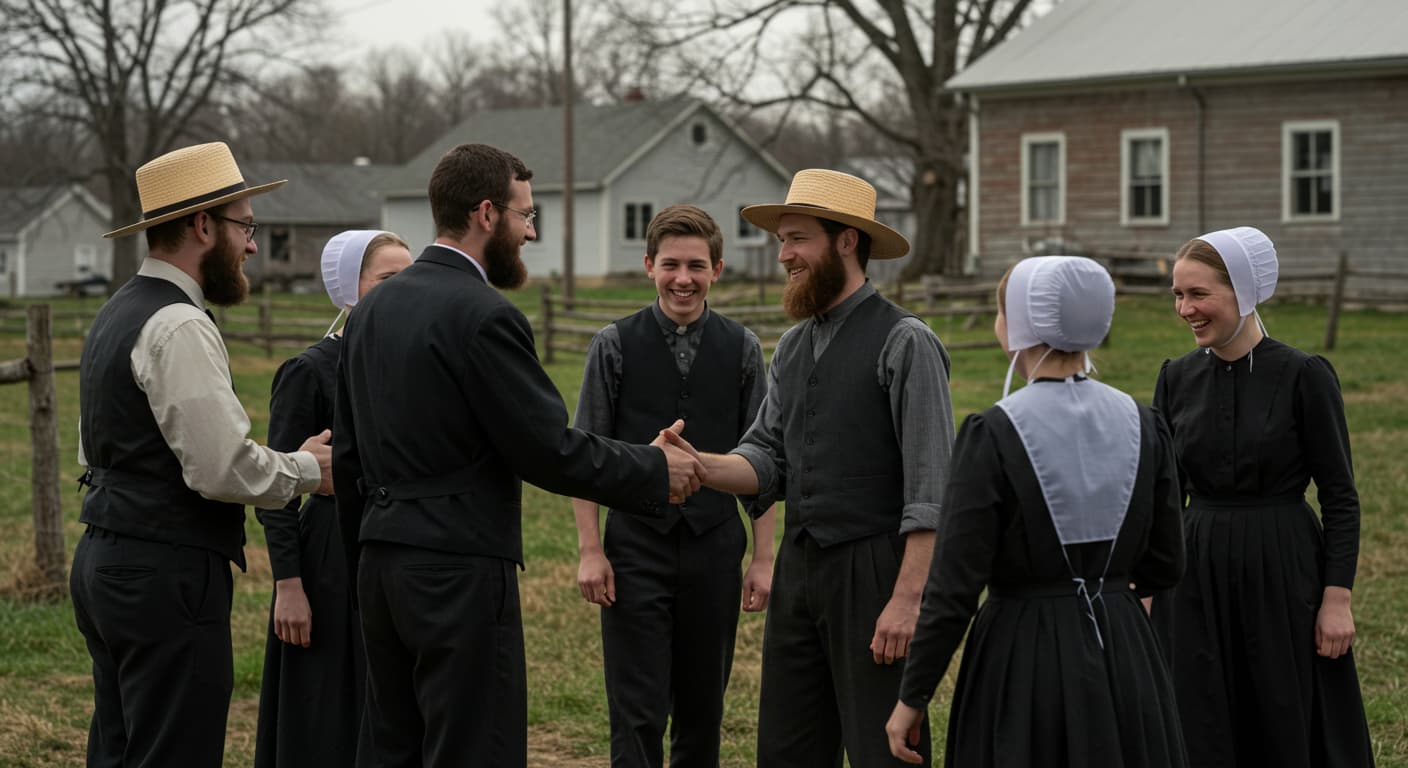The Holy Kiss in Amish Tradition—Explained.
The Amish holy kiss is a special greeting practiced by Amish church members. It’s a tradition with roots in the Bible and is a way to show love, respect, and fellowship among members of their faith. Although it might seem surprising to outsiders, the holy kiss is an important part of Amish life and is done with deep meaning and reverence.
Where Does the Holy Kiss Happen?
The holy kiss is exchanged in specific situations, mostly before Amish church services. Before the service starts, the men and women gather separately. Men might stand near the barn, while women gather inside the home. When new people arrive, they greet others in their group by shaking hands, and in some cases, exchanging the holy kiss.
This tradition is also part of other special events in the church, such as:
- Baptism: A bishop gives the holy kiss to men who are being baptized, while his wife does the same for the women.
- Communion Services: Members may exchange the holy kiss as part of this sacred ceremony.
- Ordinations: When new leaders or ministers are chosen, the holy kiss is a way to honor and welcome them.
What Does the Holy Kiss Look Like?
The holy kiss isn’t just a light peck on the cheek. Among the Amish, it is a full kiss on the lips. However, men kiss other men, and women kiss other women. Men and women do not exchange this kiss with each other.
While Amish people don’t usually show physical affection in public, this kiss is an exception. It’s not about romance but about showing a bond of trust and unity within the church community.
Why Do the Amish Practice the Holy Kiss?
The Amish follow this tradition because they believe it is commanded in the Bible. Several verses in the New Testament talk about greeting others with a holy kiss:
- Romans 16:16: “Salute one another with a holy kiss.”
- 1 Corinthians 16:20: “Greet ye one another with a holy kiss.”
- 2 Corinthians 13:12: “Greet one another with a holy kiss.”
- 1 Thessalonians 5:26: “Greet all the brethren with a holy kiss.”
- 1 Peter 5:14: “Greet ye one another with a kiss of charity.”
These scriptures guide Amish people in many areas of life, including how they greet one another. They see the holy kiss as a way to follow these biblical teachings and to show their commitment to God and to each other.
How Is the Holy Kiss Different Among Amish Groups?
Not all Amish groups practice the holy kiss in the same way. In some groups, only the church ministers exchange the holy kiss. In others, all baptized church members participate. For example, New Order Amish churches tend to include more members in this practice.
What Is the Purpose of the Holy Kiss?
The holy kiss is more than just a tradition. It symbolizes love, respect, and unity. It reminds church members to live in harmony with one another and to support each other in their faith.
The Amish also believe the holy kiss should reflect purity and sincerity. It’s not just a routine gesture but a way to show genuine care for one another. If someone’s heart isn’t right—if they are not living in love and holiness—then the holy kiss loses its meaning.
What If Someone Isn’t Amish?
Visitors to Amish church services are not expected to participate in the holy kiss. In fact, it is mainly reserved for baptized members of the church. If a visitor is unsure about what to do, they can simply observe or shake hands if they feel comfortable.
Amish people understand that this tradition may feel unusual to those who are not familiar with it.
There’s a story about a visitor who misunderstood the practice. She was told, “You don’t have to. It’s up to you,” by an Amish woman during greetings. While the visitor felt nervous, the Amish woman likely only meant that the visitor could join in by shaking hands, not kissing. This shows that Amish people are welcoming and do not pressure outsiders to participate in their traditions.
How Do the Amish Keep This Tradition Sacred?
The Amish emphasize that the holy kiss is not just a cultural tradition or a casual greeting. It is meant to be a holy act done with purity and respect. They believe that the practice must be rooted in love and a genuine commitment to their faith. As stated in the Amish booklet The Truth in Word and Work (p. 57):
- The holy kiss is a Christian greeting commanded in the Bible.
- It is a token of love and fellowship with one another and with God.
- It must be practiced regularly by Christians as a sign of their faith and brotherhood.
If someone does not live according to these values, the holy kiss becomes meaningless. Like other Amish practices, the focus is on sincerity and a pure heart.
How Does the Holy Kiss Compare to Other Church Practices?
Some Christian churches have a similar practice called the “sign of peace.” This is usually a handshake or a verbal greeting exchanged during services. However, few churches follow the biblical command of exchanging a literal kiss like the Amish do. The Amish view the holy kiss as an important and unchanging part of their faith, while other churches may see it as symbolic or outdated.
Are There Any Stories About the Holy Kiss?
Amish life often comes with interesting stories, and the holy kiss is no exception. In one tale, a visitor to an Amish church service was nervous about the holy kiss after hearing about it beforehand. She feared she might be expected to join in.
The situation turned out to be less awkward than she thought, as the Amish welcomed her warmly and made it clear she didn’t have to do anything she wasn’t comfortable with. Such moments highlight the kindness and understanding of the Amish community.
What Resources Explain the Holy Kiss?
If you want to learn more about the holy kiss and other Amish practices, the following books and resources are helpful:
- The Truth in Word and Work (a publication by the New Order Amish of Holmes County, Ohio)
- The Amish Way: Patient Faith in a Perilous World by Donald B. Kraybill, Steven M. Nolt, and David L. Weaver-Zercher
These books provide insights into Amish beliefs and how they live their faith daily.
The Amish holy kiss is a unique and meaningful tradition rooted in biblical teachings. It serves as a way to show love, unity, and fellowship among church members. While it may seem unusual to outsiders, it is a sacred practice for the Amish that reflects their deep commitment to their faith and each other.

